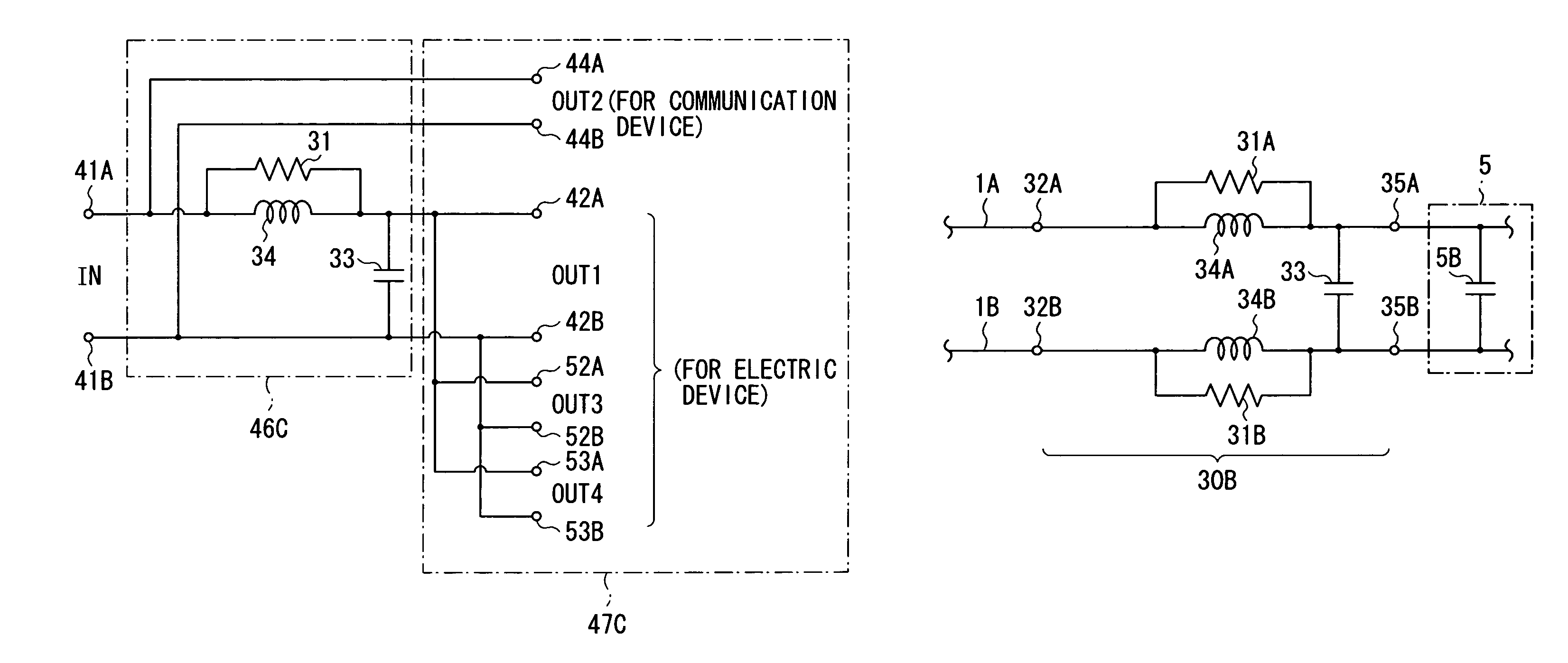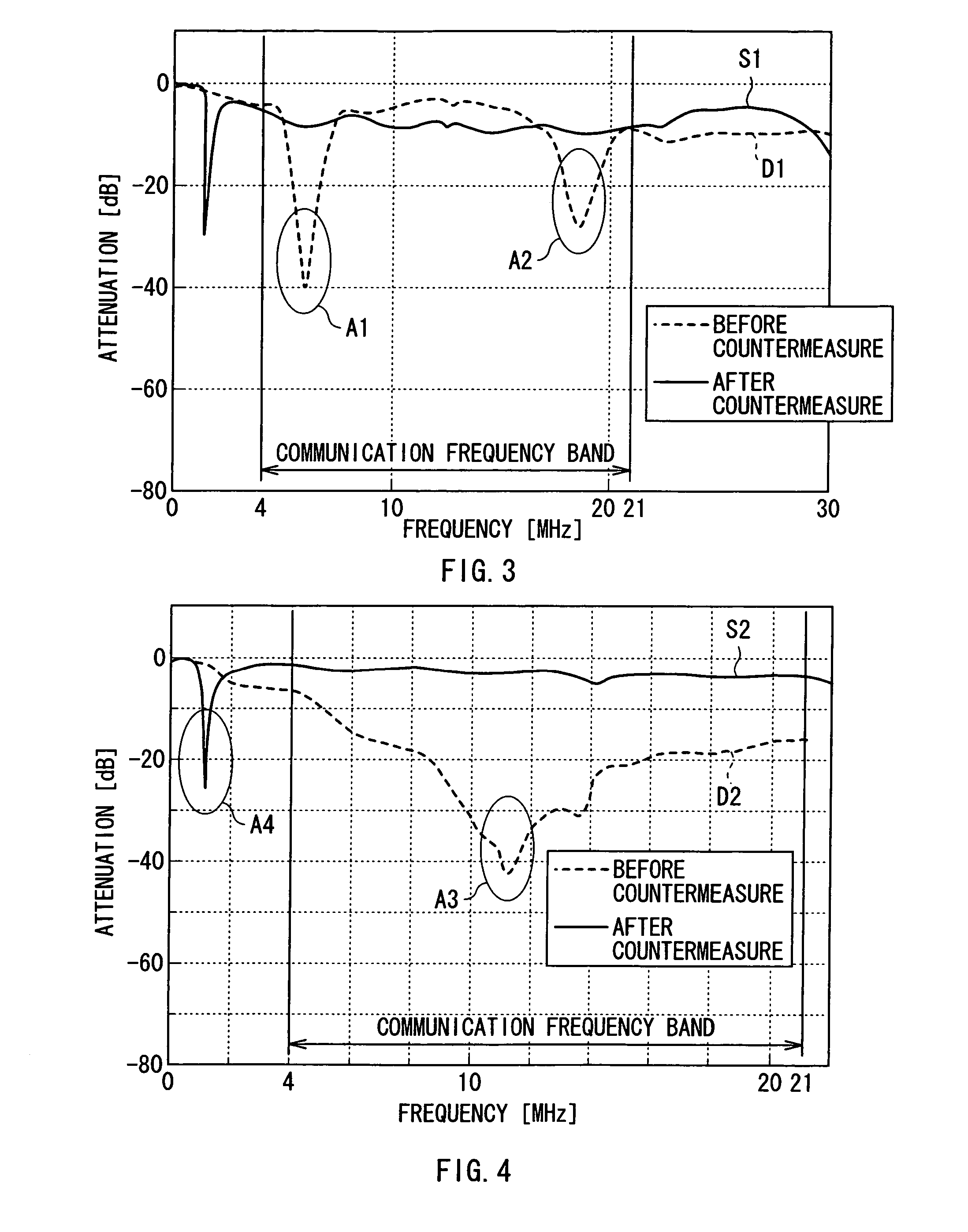Power line terminating circuit and method, and power line relay device
a technology of terminating circuit and relay device, which is applied in the direction of ignition automatic control, electric controller, instruments, etc., can solve the problems of large terminating circuit size, communication signal deterioration, and environment not always adapted to communication, so as to reduce the influence of noise
- Summary
- Abstract
- Description
- Claims
- Application Information
AI Technical Summary
Benefits of technology
Problems solved by technology
Method used
Image
Examples
first embodiment
[0044]First, a power line terminating circuit according to a first embodiment of the invention will be described. Since a power line terminating method according to an embodiment of the invention is embodied by the power line terminating circuit of the embodiment, it will be also described below.
[0045]FIG. 1 shows a circuit configuration of the power line terminating circuit in the embodiment. A power line terminating circuit 30U is applied to, for example, indoor wiring of a general house shown in FIG. 12 and is provided in an outlet (for example, the outlets 2C and 2D in the branch parts B1 and B2 in FIG. 12) provided in an indoor wall. As shown in FIG. 1, the power line terminating circuit 30U is provided between terminations 32A and 32B of a pair of indoor power lines 1A and 1B and a pair of connection terminals 35A and 35B. In this case, the terminations 32A and 32B are wiring ends in wall outlets, and the pair of connection terminals 35A and 35B are socket terminals to which t...
first modification
[0073]FIGS. 5A and 5B show a power line relay device according to a first modification of the embodiment as an example where an input and an output are provided in a one-to-one correspondence manner. FIG. 5A shows an outside structure, and FIG. 5B shows a circuit configuration.
[0074]A power line relay device 40 is provided to relay power supply from existing outlets (for example, the outlet 2C in FIG. 12) of the indoor power lines 1A and 1B to the electric device 5. The “existing outlet” is not preliminarily provided on assumption of performing the power line communication but a conventional normal outlet used in a general house.
[0075]As shown in FIGS. 5A and 5B, the power line relay device 40 has a pair of connection plugs 41A and 41B functioning as an input terminal IN, a pair of electric-device-connection sockets 42A and 42B functioning as an output terminal OUT, and a casing 43 housing a power line terminating circuit having the configuration shown in FIG. 5B. The power line ter...
modification 2
[0079]FIGS. 6A and 6B show a power line relay device according to a second modification of the embodiment as an example where one input and two outputs are provided. FIG. 6A shows an outside structure, and FIG. 6B shows a circuit configuration. The same reference numerals are designated to the same components as those shown in FIGS. 5A and 5B and their description will not be repeated.
[0080]A power line relay device 50 is provided to relay power supply from, for example, the outlet 2A (FIG. 12) as the terminations of the indoor power lines 1A and 1B to the communication device (transmitter 3, receiver 4, or the like) and the electric device 5, and to relay a communication signal among the communication devices and the indoor power lines 1A and 1B.
[0081]The power line relay device 50 has the pair of electric-device-connection sockets 42A and 42B functioning as a first output terminal OUT1 and, in addition, a pair of communication device connection sockets 44A and 44B functioning as a...
PUM
 Login to View More
Login to View More Abstract
Description
Claims
Application Information
 Login to View More
Login to View More - R&D
- Intellectual Property
- Life Sciences
- Materials
- Tech Scout
- Unparalleled Data Quality
- Higher Quality Content
- 60% Fewer Hallucinations
Browse by: Latest US Patents, China's latest patents, Technical Efficacy Thesaurus, Application Domain, Technology Topic, Popular Technical Reports.
© 2025 PatSnap. All rights reserved.Legal|Privacy policy|Modern Slavery Act Transparency Statement|Sitemap|About US| Contact US: help@patsnap.com



